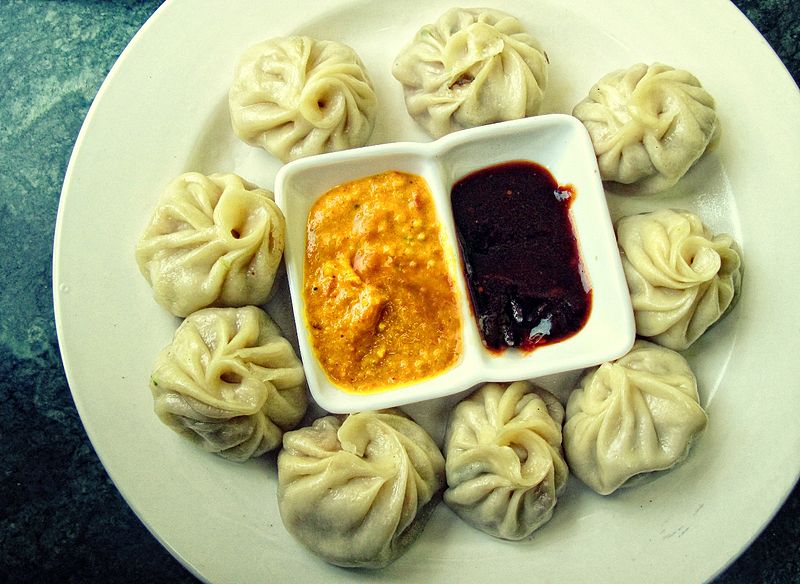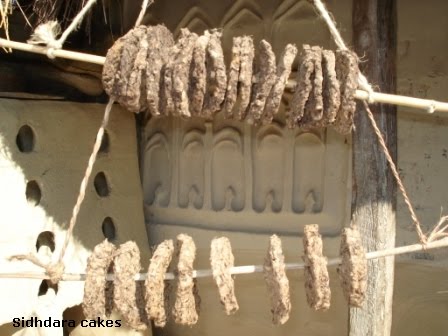Nepal, a land of diverse culture and tradition, has its own unique dishes that leave the taste buds craving for more. The delicacies presented here have been selected from hundreds of mouth-watering recipes originating from the high mountains to the Nepalese plains.
1. Sel roti
The famous Nepali crispy doughnut [1] (sel roti), a must during the Tihar or Deepawali festival [2], is prepared from rice flour.
See NepaliMom’s instructions to cook the doughnuts:
2. Gundruk
Gundruk [3], a popular dish among Nepalis, is prepared by fermenting and drying leafy vegetables, namely mustard and radish leaves. The blog Nepali Local Food [4] explains how to cook gundruk ko jhol (soup).
Gundruk ko jhol (soup)
Serves 6 to 8
Gundruk/Sinki 50 g
Onion 1 chopped
Tomato 1 chopped
Dry red chili 2 pods
Turmeric powder 1/2 Tablespoon
Salt 1 Teaspoon
Method: Soak Gundruk/Sinki in water for 10 min. Heat oil and fry chopped onions, tomatoes, chilies. Drain up soaked Gundruk/Sinki and fry, add turmeric powder and salt, and put 2 cups of water. Boil for 10 min, and serve hot with cooked rice.
3. Momo
 [5]
[5]A typical serving of momo with sesame yellow sauce and red ginger chilli sauce in Nepal. Image from Wikimedia Commons by Kushal Gayal. CC BY-SA
Momo, a type of Tibetan dumpling, is so popular among Nepalis that it could be considered the country's top dish. The ubiquitous restaurants selling the dumplings generally stuff it with minced buffalo meat, chicken, mutton or vegetables.
Check out the step-by-step momo cooking guide in the Taste of Nepal [6] blog. Or watch a YouTube video posted by Pucca syanu showing how to cook them:
4. Chhoila
Chhoila, a favourite dish among the Newars of Kathmandu Valley, has become popular throughout the country. Generally made from buffalo meat, the burnt version called “haku chhoila” (black chhoila) is very tasty. Check the We All Nepali [7]blog for details of cooking chicken chhoila.
Watch Babus Cooking demonstrating chhoila preparation:
5. Chatamari
Chatamari, also called Nepali pizza, is a kind of rice crepe made famous by the Newars of Kathmandu Valley. The blog We All Nepali [8] offers details on how to prepare it.
See how chatamari is made in this YouTube video [9] by Marc Wiens:
6. Bagiya
Bagiya is a healthy and delicious dish made from rice flour savoured especially during the Deepawali festival in eastern Terai of Nepal. It is a special to the indigenous Tharus. While Tharus in eastern Nepal prefer flat bagiya with lentils, the Tharus in western Nepal prepare bagiya in a tubular shape without lentils, explains the blog Voice of Tharus [10].
Learn how to make it via Voice of Tharus [11]:
Soak the rice is soaked in water and mill it in a dheki, the traditional rice milling machine. The taste of the flour ground in a dheki is many times better than the one ground in a rice mill.
Sift the flour and fry it in an iron cauldron (Don't add oil and keep in mind not to burn the flour).
Mix warm water to the flour and knead enough to prepare a tender dough.
Steam lentils and add spices, ginger, mustard oil and salt to it.
Make round dumplings out of the dough. Bore a hole, put the mixture of lentils and spice and flatten it with the palms at the middle and leave both the ends protruding out.
Steam the dumplings over a clay pot of boiling water.
Serve the steamed bagiya with chutney or vegetable curry.
7. Sidhara
Sidhara [12] is prepared from taro stem, turmeric, and dried fish. The aroma is pungent and the taste bitter, but still it is one of the delicacies eaten by the Terai dwellers especially indigenous peoples like the Tharus, Danuwars, Musahars and others.
The blog Voice of Tharus [13] details the cooking of Sidhara:
Gather the Dedhna and Ponthi varieties of fish. Both the varieties are found in abundance in the paddy fields and public water sources.
Dry the fishes on sun. It will take few days to dry perfectly.
Gather Kachu (taro – Colocasia) stems and cut them into small pieces. Wash them thoroughly.
Grind or mill the dried fishes, together with the colocasia stem and turmeric, and make small cakes.
Leave the cakes to dry on the sun for 10-15 days and after that it store in a dry place for future use. Your sidhara is then ready to cook and eat.
To cook the sidhara, crumple and break the cakes into tiny crumbs. Fry the pieces of sidhara in mustard oil together with onion, green chillies, radish and spices. Add water and salt to taste.
Garnish the dish with green coriander leaves and serve with puffed and beaten rice.
